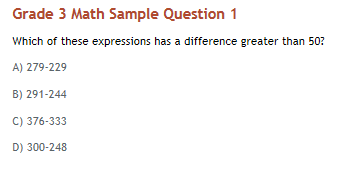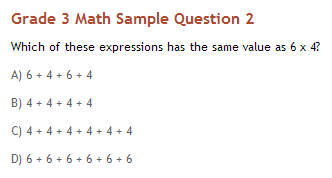Return To Teachers Speak
Though the questions themselves may look similar to the questions teachers and students are familiar with on the current NJ ASK, the new PARCC assessment will introduce some novel formatting and response techniques that will increase the rigor of standardized testing.

This week we will investigate sample questions for Mathematics to highlight the major differences between the NJ ASK and PARCC. Please note that while the questions below are based on sample questions for Grade 3, this discussion applies to all grade levels, as the test format, computer skills that students will need, and the philosophy in creating the questions are similar — regardless of grade level, mathematical content, or task complexity.
Difference #1: Movement Away From Traditional Multiple Choice
Read this sample question:
“Patricia needs to read for 120 minutes each week.
• She read for 26 minutes on Monday.
• She read for 39 minutes on Tuesday.
• She read for 38 minutes on Wednesday.
How many more minutes does Patricia need to read this week?”
With this type of question, students will be required to type the correct answer into a box. As opposed to the possibility of “guessing” the right answer with multiple choice, the probability of guessing the exact number is very low, thus ensuring that accurate responses are due to solving the problem correctly (and not just choosing the right letter).
Also, it is possible for students to succeed with the task using different methodologies to solve the problem. This allows for diverse thinking and addresses the fact that there are different ways to arrive at the same answer, thus avoiding a one-size-fits all mentality.
Here is another sample question that moves away from a multiple-choice format: “Drag each fraction to the correct location on the number line.” (Students are then provided with several fractions and a number line to use.) Like the previous question, this sample is more rigorous than simply providing points on a line with four choices for the correct location. Here, students will need to have developed their number sense in order to drag the fraction to the correct spot.
Other questions ask students to “Click on all equations that are true.” With the possibility of more than one correct answer, this departs from the traditional multiple-choice options of “All of the above”, “Both b and c”, etc.
Another variation on the theme of having more than one correct answer is in a sample question that asks students to drag tiles to make an inequality statement true. Students are alerted that “There is more than one correct answer.”
Again, the chance for guessing correctly is low: in fact, the test creators mention that this format is “entirely machine scorable without losing any important data about students’ mathematical thinking” (from www.ccsstoolbox.com/parcc/PARCCPrototype_main ). Because there are many possible responses that would be correct, the students’ success lies in their reasoning ability rather than choosing from a limited menu of options.
Difference #2: Drop-Down Menus
Check out the following sample question:
“For a school field trip, 72 students will be travelling in 9 vans. Each van will hold an equal number of students. The equation shows a way to determine the number of students that will be in each van: 72 ÷ 9 = ?”
The problem goes on to ask students how this equation can be rewritten with a different operation. Three drop-down menus are provided with the numbers 9 and 72, along with +, -, x, and ÷ . Students must fill in the boxes: ___ ___ ___ = 72.
Clearly, this requires students to consider the different combinations of numbers and operations to create the correct equation, as opposed to merely looking at a list of four preselected equations and choosing the right one.
Difference #3: Typing Short Responses
In Part C of another sample question, students are asked to “Explain how the fraction strips can show that the fractions and are equivalent.”
(www.ccsstoolbox.com/parcc/PARCCPrototype_main)
Certain portions of the test (like this one) will ask students to write short responses that justify, explain or describe their reasoning. This means that the student must use his or her word-processing skills to type a coherent response. Incidentally, the assessment features tools such as copy and paste, bold, etc. to provide more options in responding to this type of question. Obviously, the major difference here is that most students will be typing instead of writing their answers in these short constructed response sections, though there are pencil-and-paper accommodations for students who qualify.
For more sample questions and explanations, visit PARCC’s website at: www.parcconline.org/samples/item-task-prototypes. Next week you’ll get a sneak peek at the ELA sample questions, along with a discussion of how the new format may impact your students and classroom instruction in preparation for the PARCC implementation.
For the next part of this post, please click on the following link,
“A Review of Sample Questions Released by PARCC: Implications for Mathematics (PART II) – by Julie C. Lyons”








Pingback: A Review of Sample Questions Released by PARCC: Implications for Mathematics | Think Educative
Generally I do not learn article on blogs, but I would like to say that this write-up very forced me to take a look at and do it! Your writing taste has been surprised me. Thank you, very great post.
It’s in point of fact a nice and helpful piece of information. I am happy that you shared this helpful information with us. Please stay us up to date like this. Thanks for sharing.